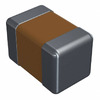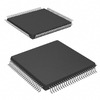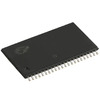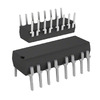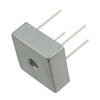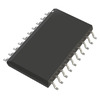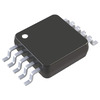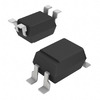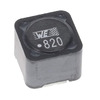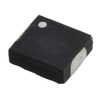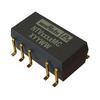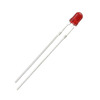74HC164 Register: Pinout, Truth Table, and Datasheet
The 74HC164, a component from the 7400 logic family, is an 8-bit shift register that amplifies microcontroller capabilities through its ability to handle both serial inputs and parallel outputs. Its high-speed CMOS design supports effective expansion of output pins. When managing devices like LED arrays and LCDs, in contexts with limited microcontroller output pins, the 74HC164 offers substantial utility by transforming serial data into parallel output across its eight pins. This article delves into the many facets of the 74HC164, including its design, operational characteristics, and application, providing a comprehensive overview of its capabilities and benefits in modern electronics.Catalog

What is the 74HC164?
The 74HC164 serves various purposes in electronic scenarios where extra output pins may be desired, functioning as an 8-bit shift register. It effectively processes serial input data while providing asynchronous parallel outputs, making it fitting for interfacing with switches, LEDs, sensors, or systems needing 8-bit parallel input. In LED arrays and displays, this component adeptly addresses microcontroller output pin constraints by simplifying connections and reducing circuit complexity. Its utility spans a variety of applications, such as data conversion and communication systems, facilitating smooth serial-to-parallel data transitions.
Equivalent and Alternative Models for 74HC164
• 74HC164D
• 933714070652
Pinout of 74HC164
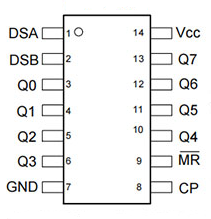
|
Pin Number |
Pin Name |
Function |
|
1 |
DSA |
Serial Data Input |
|
2 |
DSB |
Serial Data Input |
|
3 |
Q0 |
Data Output |
|
4 |
Q1 |
Data Output |
|
5 |
Q2 |
Data Output |
|
6 |
Q3 |
Data Output |
|
7 |
GND |
Ground |
|
8 |
CP |
Clock Pulse -Positive Edge Triggered |
|
9 |
MR |
Master Reset - Asynchronous |
|
10 |
Q4 |
Data Output |
|
11 |
Q5 |
Data Output |
|
12 |
Q6 |
Data Output |
|
13 |
Q7 |
Data Output |
|
14 |
Vcc |
Supply Voltage |
74HC164 Symbol and Footprint


Features of 74HC164
Voltage Range and Power Adaptability
The 74HC164 operates within a flexible voltage range from 2V to 6V, allowing seamless integration into various circuit environments. It adapts to both standard and reduced power levels, enhancing efficiency without the added complexity of voltage regulation Hardware. The embrace of modern design practices often aligns with this adaptability, guiding efficient power utilization.
Current and Power Dynamics
The 74HC164 is well-suited for low-power scenarios, drawing a maximum current of just 100µA, making it ideal for battery-operated devices. Its output supports a current capacity of ±25mA, providing strong signal driving performance. Within larger systems, this efficiency contributes to a reduced power footprint, potentially extending device life and improving performance.
Clock Frequency and Data Processing
Handling clock frequencies up to 54MHz, the 74HC164 meets rapid data processing and transmission needs in high-speed applications like communication systems. Components with such capacities can notably enhance processing speed and efficiency, fostering advancements in technology that demand swift and reliable data handling.
Energy Efficiency and CMOS Technology
Utilizing CMOS technology, the 74HC164 exemplifies low-power consumption in today's electronic device design. CMOS's minimal energy requirements during idle phases help lessen thermal output, addressing concerns over device overheating and extending operational lifespan.
Packaging and Design Flexibility
Available in various package types such as PDIP and SOIC, the 74HC164 offers design the freedom to choose the ideal form factor for their applications. Whether compactness or prototype handling ease is prioritized, this versatility supports streamlined design processes and scalable production methods.
Elevated ESD Protection
Enhanced ESD protection surpassing JESD 22 standards adds a layer of security against electrostatic discharge damage. This aspect bolsters the semiconductor's durability and reliability within static-prone environments. In practical applications, strong ESD safeguards decrease failure rates and reduce maintenance costs, leading to greater device consistency and customer satisfaction.
Specifications of the 74HC164D
|
Type |
Parameter |
|
Factory Lead Time |
12 Weeks |
|
Package / Case |
SOIC (0.154, 3.90mm Width) |
|
Number of Pins |
14 |
|
Operating Temperature |
-40°C~125°C |
|
Series |
74HC |
|
Part Status |
Active |
|
Number of Terminations |
14 |
|
Terminal Position |
DUAL |
|
Peak Reflow Temperature (Cel) |
NOT SPECIFIED |
|
Frequency |
78MHz |
|
Function |
Serial to Parallel |
|
Supply Voltage-Max (Vsup) |
6V |
|
Number of Circuits |
8 |
|
Family |
HC/UH |
|
Output Polarity |
TRUE |
|
Propagation Delay (tpd) |
240 ns |
|
Count Direction |
RIGHT |
|
REACH SVHC |
No SVHC |
|
Lead Free |
Lead Free |
|
Mounting Type |
Surface Mount |
|
Surface Mount |
YES |
|
Number of Elements |
1 |
|
Packaging |
Cut Tape (CT) |
|
Published |
2016 |
|
Moisture Sensitivity Level (MSL) |
1 (Unlimited) |
|
Voltage - Supply |
2V~6V |
|
Terminal Form |
GULL WING |
|
Supply Voltage |
4.5V |
|
Time@Peak Reflow Temperature Max (s) |
NOT SPECIFIED |
|
Output Type |
Push-Pull |
|
Supply Voltage-Min (Vsup) |
2V |
|
Number of Bits |
8 |
|
Logic Type |
Shift Register |
|
Trigger Type |
POSITIVE EDGE |
|
fmax-Min (MHz) |
24 MHz |
|
Width |
3.9mm |
|
RoHS Status |
RoHS Compliant |
Utilizing the 74HC164 in Advanced Designs
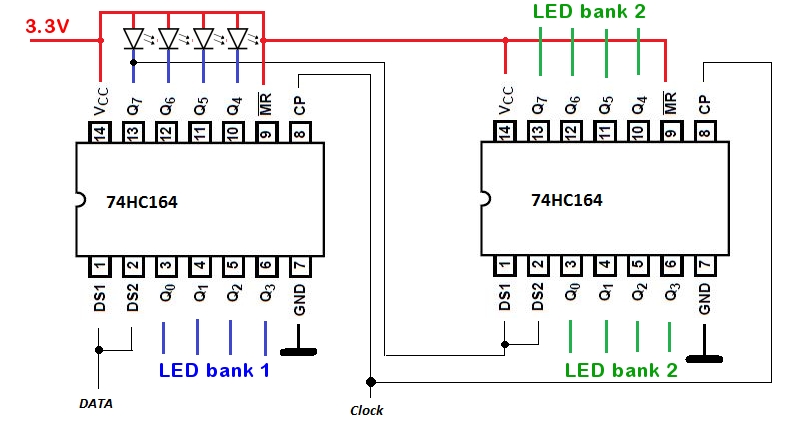
The seamless integration of the 74HC164 with microcontrollers involves minimal pin usage, enhancing space and efficiency in circuit design. The clock signal gracefully orchestrates the data transfer from two serial inputs to parallel outputs, creating a smooth and effective process. When outputs reflect data across an 8-bit port, it ensures effortless data management with pin connections. Acting as the core rhythm of data transfer, the clock signal guarantees data movement at precise intervals. This synchronization imbues digital systems with accuracy and reliability. Others find immense value in the clock synchronization of the 74HC164, especially in timing-sensitive scenarios like signal processing.
The 74HC164 enhances data management by smoothly converting serial input into parallel output. This reduces wiring complexity and decreases the chance for errors, making system design simpler and accelerating development cycles with easier troubleshooting. The 74HC164 is prized for its straightforward functionality and dependability. Its use is often considered in digital displays or systems demanding multiple outputs but limited control lines. Many admire its capacity to extend I/O capabilities without imposing extra pin burdens on microcontrollers. The tactical benefit of using the 74HC164 lies in addressing the constraints of limited I/O ports on microcontrollers. By shifting outputs from serial to parallel, you can strategically reallocate microcontroller resources, unlocking additional functionalities and enhancing performance within existing hardware limits.
Truth Table for 74HC164

Applications of 74HC164
Versatile Logic Applications
The 74HC164 serves as a versatile entity in general-purpose logic, bringing advantages to electronic systems by streamlining multiple data streams. Its integration allows to improve efficiency and performance across diverse applications.
Integration in Consumer Electronics
In devices like personal computers and televisions, the 74HC164 enriches data processing and control. By facilitating smoother operations, it enhances device responsiveness, enriching and supporting demanding environments.
Peripheral Device Enhancement
Used in peripherals such as keyboards and printers, the 74HC164 enhances functionality through its data handling capabilities. It ensures seamless interaction between devices and host systems, promoting synchronized operations.
Networking Device Optimization
For networking devices, the 74HC164 aids in swift data transfer and management. It organizes and processes information serially, boosting network speed and reliability. Its use helps alleviate bottlenecks, contributing to efficient network infrastructures.
Packaging of 74HC164

74HC164 Manufacturer Information
Toshiba gains recognition for its diversified portfolio in electronics, influencing sectors like semiconductors and digital technologies. Its capacity to deliver robust and innovative solutions is evident across various domains, including consumer electronics and intricate IT infrastructures. Toshiba demonstrates a deep commitment to innovation through consistent investment in research and development, ensuring it meets the dynamic needs of modern markets. This dedication shines through in its development of advanced semiconductors in numerous applications such as communication devices and industrial machinery. Anticipating tech trends, Toshiba strategically addresses forthcoming challenges and seizes new opportunities. Through groundbreaking work in quantum computing and AI technologies, Toshiba shapes future paradigms, guiding the course of technological progress and maintaining its leadership in a competitive marketplace.
Datasheet PDF
74HC164D Datasheets:
Frequently Asked Questions [FAQ]
1. What’s the difference between 74LS164 chip and 74HC164 chip?
The 74LS164 utilizes TTL technology, operating optimally with a stable 5V supply. This requirement aligns well with systems following TTL logic standards, though it results in higher power consumption. On the other hand, the 74HC164 is based on CMOS technology, offering an operational voltage range from 2V to 6V. This range provides adaptability for energy-efficient designs, fitting seamlessly into battery-powered devices. Many choose between them by weighing power consumption and supply voltage, always guided by system compatibility and the specific needs of each application.
2. What’s the difference between 74HC164 and 74HC595?
The 74HC595 features an output latch and an OE (Output Enable), which enhances the stability of output data. This is useful for applications demanding consistent and synchronized control, minimizing the likelihood of glitches during high-speed tasks. In contrast, the 74HC164 provides direct shift output with an asynchronous reset, offering simplicity in scenarios where minimal external management is needed. Circuit design with these components balances between control complexity and operational simplicity, presenting opportunities for creative solutions in engineering challenges.
3. What is 74HC164?
The 74HC164 is identified as an 8-bit shift register with serial input and parallel output, simplifying data management when expanding outputs from a microcontroller. It is commonly employed to create efficient data pipelines, driving multiple outputs in LED displays or similar arrays. By leveraging its straightforward yet adaptable design, you can extend functionality without complicating the circuitry. This reflects a preference for simplicity and efficiency in design solutions, aligning with broader trends towards streamlined in electronics development.
About us
ALLELCO LIMITED
Read more
Quick inquiry
Please send an inquiry, we will respond immediately.

A Comprehensive Guide to the 74LS04
on October 24th
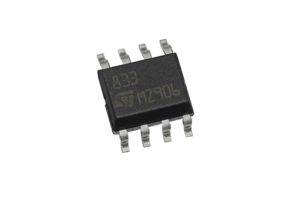
Exploring the LM833DT Operational Amplifier
on October 24th
Popular Posts
-

What is GND in the circuit?
on January 1th 2924
-

RJ-45 Connector Guide: RJ-45 Connector Color Codes, Wiring Schemes, R-J45 Applications, RJ-45 Datasheets
on January 1th 2484
-

Fiber Connector Types: SC Vs LC And LC Vs MTP
on January 1th 2075
-

Understanding Power Supply Voltages in Electronics VCC, VDD, VEE, VSS, and GND
on November 8th 1863
-

Comparison Between DB9 and RS232
on January 1th 1756
-

What Is An LR44 Battery?
Electricity, that ubiquitous force, quietly permeates every aspect of our daily lives, from trivial gadgets to life-threatening medical equipment, it plays a silent role. However, truly grasping this energy, especially how to store and efficiently output it, is no easy task. It is against this background that this article will focus on a type of coin cell battery that may seem insignificant on the...on January 1th 1706
-

Understanding the Fundamentals:Inductance Resistance, andCapacitance
In the intricate dance of electrical engineering, a trio of fundamental elements takes center stage: inductance, resistance, and capacitance. Each bears unique traits that dictate the dynamic rhythms of electronic circuits. Here, we embark on a journey to decipher the complexities of these components, to uncover their distinct roles and practical uses within the vast electrical orchestra. Inductan...on January 1th 1649
-

CR2430 Battery Comprehensive Guide: Specifications, Applications and Comparison to CR2032 Batteries
What is CR2430 battery ?Benefits of CR2430 BatteriesNormCR2430 Battery ApplicationsCR2430 EquivalentCR2430 VS CR2032Battery CR2430 SizeWhat to look for when buying the CR2430 and equivalentsData Sheet PDFFrequently Asked Questions Batteries are the heart of small electronic devices. Among the many types available, coin cells play a crucial role, commonly found in calculators, remote controls, and ...on January 1th 1536
-

What Is RF and Why Do We Use It?
Radio Frequency (RF) technology is a key part of modern wireless communication, enabling data transmission over long distances without physical connections. This article delves into the basics of RF, explaining how electromagnetic radiation (EMR) makes RF communication possible. We will explore the principles of EMR, the creation and control of RF signals, and their wide-ranging uses. The article ...on January 1th 1528
-

CR2450 vs CR2032: Can The Battery Be Used Instead?
Lithium manganese batteries do have some similarities with other lithium batteries. High energy density and long service life are the characteristics they have in common. This kind of battery has won the trust and favor of many consumers because of its unique safety. Expensive tech gadgets? Small appliances in our homes? Look around and you'll see them everywhere. Among these many lithium-manganes...on January 1th 1497


